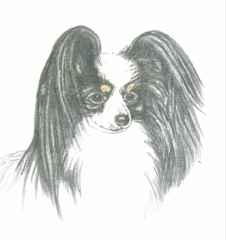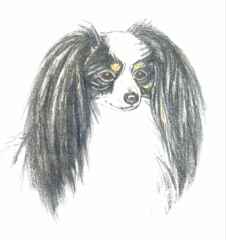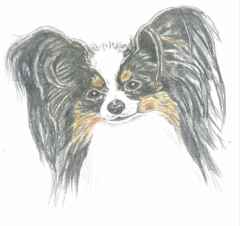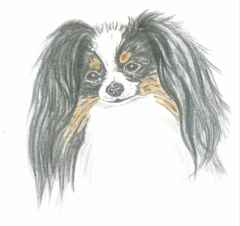

| ©2005 Ms D E Ashdown |
| (You are not permitted to copy any illustrations from this site - please note copyright warning on Home Page) |
|
The following are just a few examples of some of the illustrations to be included in the book. It should of course be noted that these standard pictures were scanned from copies of the original drawings and reproduced on a home computer. As such they do not reflect the quality and clarity which the originals included in the book will show. On the originals there are fine pencil shadings but these will not reproduce on the photocopies we used for scanning purposes. Hence on the pictures reproduced on this site some of the areas of white look a bit odd without any shadings at all. |
|
Most of the drawings for the Illustrated Standard are in sequences – as
many as 18 in one sequence, often 10 or 12 but sometimes only 3 or 4. We
are including some complete sequences to help readers and viewers get a
better overall idea of the content, the attention to detail and the
creativity of this unique Book. Nothing like it has ever been done before,
to the best of our knowledge. BITE 5 drawings all taken from the same template. |
|
|
|
|
| A | B | C |
|
|
|
| D | E |
|
|
|
(A) shows Jenny Scovell’s red and white
“Willow” (Caswell Copper Charmer) as himself, though disguised as a
lightly-sketched tricolour, with a correct scissor bite. Deirdre
attempted a rough concealment, thinking Jenny would not be at all happy to
see Willow modelling for this particular sequence, given that he has a
perfect mouth! However, Jenny was more than happy for Willow to be named.
In fact one of the outstanding features of the assistance people have
already given in preparing the Illustrated Standard, is their willingness
to have their own dogs depicted with not only virtues, but faults – on the
basis that all dogs, and all kennels, have faults. This is extremely
helpful to us, and a refreshing indication that there are people – people
in Papillons and Phalenes – who are honest and candid, and happy to put
the progress of the breed before any other consideration. (B) shows poor Willow with a wry mouth. All wry mouths are different. Usually the teeth do not protrude in this type of mouth (though they can do): the irregularity and unevenness of the bite is revealed externally by the twist in the jaw. Open the mouth and you can instantly see the fault. (C) shows Willow with a bad, very seriously undershot bite. The lower jaw juts forward with a correspondingly strong under jaw (like a Bulldog). The lower incisors protrude. We think it unlikely that a Papillon or Phalene with such an extreme mouth fault would be seen in the show ring – though you never know! However (D) shows a milder version of an undershot bite. The incisors only just protrude, the under jaw is not so noticeably jutting and although no Papillon should win an award with a mouth like this, some individuals with undershot mouths of this type can certainly be found, in the modern show ring as well as in classes of the distant past. Lastly, (E) shows Willow with a less obvious, but just as serious, mouth fault – a badly overshot bite. At first glance this just looks like rather a long-muzzled version of the dog. Look closer and you can see that there is no chin at all to be seen. The upper jaw overlaps the lower jaw completely to hide it - and see how thin the lower jaw line is, even at the side! Were you to see this head from the side – and we have photos in the Illustrated Std illustrating this point – you would see that the top jaw overhangs the lower in what is termed a “bird bite” (in Hungarian dentistry.) Severely overshot bites are more commonly to be seen in a long- muzzled, snipey specimen of the breed but can still occur in dogs with shorter muzzles. There are diagrams accompanying this sequence, showing the complete jaw in each instance. |
|
DIFFERENT TYPES OF COAT 6 drawings all taken from the same template |
|
|
|
|
| A | B | C |
|
|
|
|
| D | E | F |
|
This is a sable/white dog drawn in an unusual
position – semi-side-on and rather stretched out. The pose was chosen
because it is easier to see the lie of the coat this way. (A) shows a young dog with good ear fringes and plume and a moderate amount of correct silky body coat. It is evident from this moderate amount of body coat that the shape and proportions are correct. His coat also has a very slight wave. (B) shows you what he might look like when out of coat – he has sparse body coat left and has lost some of his plume though he still has his ear fringes at this stage. A Papillon with correct coat i.e. without an undercoat, will look quite naked when he has shed all his coat – like a bitch after the massive moult which follows a litter of puppies. (C) is (A) but presented in the modern show-ring fashion favoured by many (though by no means all) – the coat blow-dried so that it is entirely straight, and fluffed out to maximise the volume of air it can contain. (D) shows this trend developed to its ultimate extreme: this version of the dog, however, possesses a thick undercoat as well as a topcoat. That topcoat may or may not be harsh and straight – you can only tell that by feeling it. Note how the combination of blow-drying (presentation) and the presence of an undercoat (natural) has fluffed up the dog’s legs to make him look far heavier in bone than he actually is. This is the “teddybear” look which is a modern fad, and much deplored by older breeders and exhibitors. Lastly, on the subject of coat, (E) and (F) show two types of curly coat in the Papillon. (E) has thick, loose curls which, in this type of coat, are often silky. Something can be done with the presentation of this type of coat, through judicious stripping and thinning, and careful blow-drying. But any improvements are very temporary and the coat quickly reverts to nature. Such a coat can easily become woolly if an undercoat is present. Woolly coats felt up quickly and are characterised by their tufty, unruly quality (see photos in Book) (F) has a less common type of coat – a frizzy, smaller curl, looking rather like a bad home permanent wave! The coat is often harsh and dry. Nothing can be done to improve this type of coat. It is typically strong and thick, and difficult to groom. |
| EYES |
|
|
|
|
| A | B | C |
|
|
|
|
| D | E | F |
|
Of the four Standards in use at present, three have
different requirements for the size/shape of eye. Three out of four! The
USA Std requires a medium round eye, the FCI Std a large almond eye and
the UK Std/Australian Std a medium sized rounded eye (which is not the
same thing as a round eye). The Illustrated Standard will be contrasting and comparing these requirements, as it will all other aspects of the Standards. Here, however is a sequence of 6 drawings from one template, showing an almond eye in small, (incorrect everywhere), medium and large, and a round eye in small, medium and large sizes. A – small round eye B – medium round eye C – large round eye D – small almond eye E medium almond eye F large almond eye |
|
THE HEAD OF THE BREED There is much debate about the type of head a Phalene should have. Few people, it seems – especially those who actively dislike Phalenes – have seen a large number of Phalenes with really good heads: even fewer have seen a high proportion of Phalenes with absolutely exquisite heads. We have heard all sorts of things said about Phalenes, from both their supporters and from their opponents, in order to excuse poor type. That the Phalene is permitted to have a broader, flatter head than the Papillon, for instance; that because the Phalene has a different type of temperament from the Papillon, (undisputed by us although it should be noted we do know of phalenes whose temperaments have been as outgoing and lively as papillons), it is allowed to be nervous of strangers and more withdrawn; that it can be permitted a lower and looser tail carriage; a curlier coat – and so on, and so on. In the course of working on this Book we have, of course, studied all four Standards in minute detail, and nothing in any of the Standards would support the notion that the Phalene should be in anyway different from the Papillon other than by virtue of its ear carriage. This despite the fact that there are confusions and anomalies in all 4 Standards. None, however, relate to differences between the Papillon and the Phalene. One of the many unusual and interesting features of the Illustrated Standard is that we are including a long sequence of well-known, critically acclaimed Papillons and Phalenes and are reproducing them first as themselves, then with the ears of their “opposite” number. Some will be head studies, some will be the complete dogs. Deirdre has done three or four sets so far, but plans to do around 20. So – if you have a champion or top winning Papillon/Phalene and you would like to see what your dog looks like with “opposite” ears, get in touch with Deirdre and she may well include your dog in the Illustrated Standard. Here to start with, are two Papillons. The first is Jenny Scovell’s Ch. Caswell Classic Tri – BOB at Cruft’s this year and rounding off the year nicely with BOB and Group 4 at the LKA Ch. Show on December 11th. Here he is with his own beautiful erect ears and again with the fully dropped and fringed ears of a Phalene. Secondly Mike and Mark’s own Nouveau Less Is More, winner of 2 reserve CC's and owner of a very pretty head. Here he is with his own ears and again as he would look were he a Phalene. |
 |
 |
 |
 |
| Ch. Caswell Classic Tri | Ch. Caswell Classic Tri | Nouveau Less Is More | Nouveau Less Is More |
|
We hope
that just these two examples will indicate –as the Book seeks to
demonstrate – that there should be no difference whatsoever between
the head of a Phalene and that of a Papillon. Furthermore if allowances
are made for the Phalene, in the “interests” of promoting it, then it will
only do the Phalene a disservice. The sequence Deirdre is working on at the moment is the most difficult in the Book – they are the 8 measured drawings illustrating perfect representations of each of the 4 Standards. That is not to say they will look like the dogs currently being shown – they may, or they may not – but they will be faithful representations of the Standards. We will put the sequence on the Website when it is complete (Deirdre has done 5 out of 8) for people to see and discuss, and feed comments back to us. What is certain, even though the sequence is not finished yet, is that these 8 drawings will point up the discrepancies and the points of dispute raised by having four working standards across the continents….we think you will find this sequence very interesting. Although viewers of this site are not going to see all the Illustrated Standard’s art work in advance – Deirdre now thinks she may end up doing as many as 400 drawings – you will get to see enough of it to stimulate interest and discussion amongst yourselves, and in chat rooms. And we do want your comments, however critical. All comments and suggestions are welcome. The prime purpose, however, is to create an awareness and understanding of what this book is about, and what it aims to create and to achieve for the breed. The Website will be regularly updated, therefore, and you can look forward to some more pieces of artwork soon. |